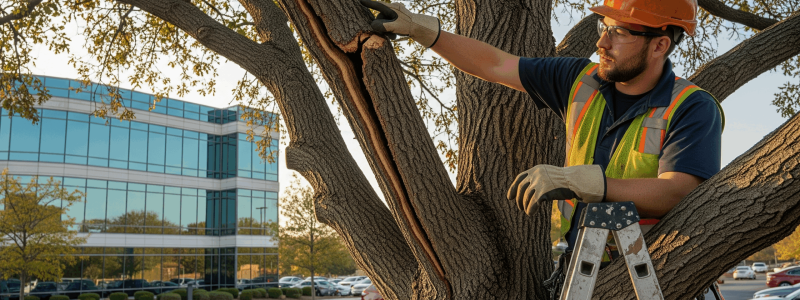How to Spot the Early Signs of High-Risk Trees
For commercial property owners, trees are more than a visual asset—they contribute to curb appeal, shade, and a welcoming environment. But when a tree becomes structurally unstable or diseased, it turns from an asset into a liability. The consequences can be severe: property damage, personal injury, or even legal repercussions. Knowing how to spot early warning signs can save your business significant costs and protect public safety.
Professional Commercial Tree Trimming Services play a critical role in managing these risks. They not only address visible issues but also identify hidden dangers that could escalate without timely intervention.
What Makes a Tree High-Risk?
A high-risk tree is one that poses a significant likelihood of failure—meaning parts of the tree, or the entire tree, could fall and cause harm. This danger is influenced by a mix of biological, structural, and environmental factors.
Structural Instability
- Leaning beyond normal growth: A sudden or progressive lean often signals root damage or soil instability.
- Cracks in the trunk or major limbs: These are structural weak points that may worsen under stress from wind or storms.
Biological Decline
- Fungal growth at the base: Indicates root decay.
- Dead or brittle branches: A sign of disease, nutrient deficiency, or pest infestation.
Environmental Stress
- Soil erosion around roots
- Storm or lightning damage
Why Ignoring Tree Risks Can Be Costly
High-risk trees don’t just represent a potential safety issue—they’re a direct threat to your financial bottom line.
- Property Damage: Falling limbs can crush vehicles, break windows, and damage roofing.
- Legal Liability: Commercial property owners can be held responsible for injuries caused by neglected trees.
- Business Disruption: An incident could block entryways, create safety hazards, and lead to temporary closure.
- Insurance Complications: Neglected maintenance records can affect claims.
Where High-Risk Trees Are Most Common
High-risk trees aren’t confined to rural or forested areas—they are often found in urban commercial spaces.
- Parking Lots: Trees surrounded by asphalt may have compromised root health.
- Outdoor Dining Areas: Heavy foot traffic can compact soil and weaken root systems.
- Building Perimeters: Trees close to structures risk damaging roofs, siding, or foundations.
- Storm-Prone Regions: High winds and heavy rain accelerate structural decline.
When to Take Action
Timing is critical when dealing with hazardous trees. Acting too late can result in damage and legal complications.
- After Severe Weather: Schedule inspections after windstorms, heavy snow, or hurricanes.
- Seasonal Checks: Spring and fall are ideal for professional assessments.
- During Visible Decline: Immediate intervention if you notice dead branches, trunk splits, or fungal growth.
Who Should Inspect and Trim High-Risk Trees
While maintenance staff may notice visible issues, only certified arborists have the expertise to assess structural integrity and disease risk. Arbor Plus employs skilled professionals who use advanced diagnostic tools to evaluate:
- Internal decay with resistograph testing
- Root health with air spade excavation
- Structural balance with visual and aerial inspection
How Professional Commercial Tree Trimming Services Mitigate Risk
A well-executed trimming plan reduces hazards, promotes healthy growth, and preserves the aesthetic value of your property.
Hazard Reduction
Removing dead or unstable limbs prevents accidents during storms.
Disease Management
Targeted cuts stop the spread of fungi and pests.
Structural Shaping
Pruning improves wind resistance and stability.
Advantages of Proactive Tree Maintenance for Commercial Properties
- Enhanced Safety: Reduces the risk of injuries and property damage.
- Improved Curb Appeal: A well-maintained landscape attracts clients and tenants.
- Cost Savings: Prevents costly emergency removals and liability claims.
- Compliance: Meets city and insurance safety requirements.
Practical Role of Trimming in Long-Term Tree Health
Proactive trimming is not just about aesthetics—it ensures longevity and sustainability for your trees. By maintaining healthy branch structure, the tree can better resist disease, pests, and environmental stressors. This is especially important in commercial spaces where trees must withstand urban stress like pollution, soil compaction, and foot traffic.
Protecting Your Investment with Arbor Plus
Commercial property owners cannot afford to overlook the risks posed by unstable trees. By partnering with Arbor Plus for expert Commercial Tree Trimming Services, you ensure your property remains safe, attractive, and compliant with safety standards. Early detection and professional care turn potential liabilities into lasting assets, protecting your reputation and your bottom line.

